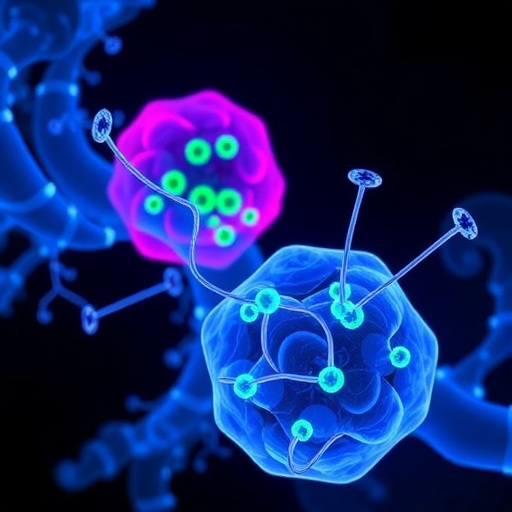In a groundbreaking study published in the Journal of Translational Medicine, researchers led by J. Yan, L. Zhong, and X. Chen have unveiled a novel two-step approach to enhance drug delivery to solid tumors by targeting Claudin-6. This cutting-edge strategy aims to revolutionize the effectiveness of treatments for patients grappling with some of the most challenging forms of cancer. The primary goal behind this innovative method is to optimize drug bioavailability and specificity, ultimately leading to improved patient outcomes.
Claudin-6 is a tight junction protein that has gained attention in recent years due to its unique expression pattern in certain types of tumors, particularly various solid tumors. The researchers undertook this ambitious project with the hypothesis that by targeting Claudin-6, they could significantly increase the precision of drug delivery, minimizing off-target effects while maximizing therapeutic efficacy. This is crucial because conventional chemotherapy often results in significant side effects and reduced quality of life for patients.
The research team meticulously designed a two-step drug delivery system that initiates with the application of a targeting agent specifically designed to bind with Claudin-6. This agent serves as a delivery vehicle, ensuring that therapeutic agents are escorted directly to the tumor site. The effectiveness of this initial step is paramount, as it lays the foundation for the subsequent phases of drug administration which are designed to ensure that a higher concentration of the drug reaches the malignant cells rather than healthy surrounding tissues.
In preclinical experiments, the team tested the targeting agent in vitro using various cell lines that express Claudin-6. The results were promising, indicating that the targeting agent effectively bound to Claudin-6 and facilitated the selective uptake of chemotherapeutic drugs by the tumor cells. This selectivity reduces the amount of drug needed to achieve an effective dose while simultaneously minimizing the potential for adverse reactions commonly seen with many cancer treatments.
Following these successful initial findings, the researchers proceeded to in vivo studies to further evaluate the delivery system’s performance in a living organism. Their approach harnessed advanced imaging techniques to track the distribution and bioavailability of the drugs post-delivery. This innovative use of imaging technology enabled the researchers to monitor precisely how effectively the Claudin-6 targeting system directed drugs to the tumor sites in live models.
One of the notable outcomes from the in vivo trials was the observed reduction in tumor size in those treated with the targeted delivery system compared to traditional administration methods. This dramatic difference highlights the potential advantages of the two-step approach, suggesting that this could become a game-changer in improving therapeutic regimens for solid tumors. Additionally, the research suggests that the targeted application of such agents could greatly diminish the frequency and severity of side effects, addressing a critical issue in cancer treatment.
The researchers are excited about the broader implications of their findings, believing that this method could easily be adapted for other therapeutic agents and various solid tumors beyond those initially targeted. Given the dynamic nature of cancer biology, the versatility of the Claudin-6 targeting system could potentially pave the way for multi-faceted treatment strategies tailored to individual patient profiles.
The findings from this study may also trigger further exploration into the roles of other tight junction proteins as potential targets for similar drug delivery strategies. This expanding area of research may encapsulate an array of novel therapeutic agents, leading to a new frontier in cancer treatment options.
Moreover, the promising results of this research have spurred interest not only among oncologists but also within pharmaceutical companies, seeking to collaborate on further developments and eventual clinical trials. The hope is that this collaborative spirit will facilitate the transition from laboratory successes to real-world applications that can transform patient care.
As the researchers continue to refine their approach and prepare for future clinical applications, the scientific community is optimistic about the possibilities this new two-step drug delivery method offers. With ongoing studies and potential partnerships on the horizon, the dream of significantly improved cancer treatments appears to be within reach.
In summary, the work led by Yan, Zhong, and Chen represents a significant step forward in the quest for effective cancer therapies, potentially heralding a new era in the management of solid tumors. The combination of precision, reduced side effects, and personalized medicine represents the future of oncology, wherein treatments could be tailored not just to the type of cancer but also to the molecular characteristics that define each patient’s condition.
As these researchers continue their essential work, the implications of their findings resonate far beyond the laboratory, bringing renewed hope to patients and families affected by cancer. The promise of new, targeted therapies can reshape the fight against cancer, underscoring the pivotal role of innovative research in transforming healthcare outcomes.
Subject of Research: Enhanced drug delivery to solid tumors through targeting Claudin-6.
Article Title: De novo design of a two-step approach targeting Claudin-6 for enhanced drug delivery to solid tumors.
Article References: Yan, J., Zhong, L., Chen, X. et al. De novo design of a two-step approach targeting Claudin-6 for enhanced drug delivery to solid tumors. J Transl Med 23, 1323 (2025). https://doi.org/10.1186/s12967-025-07316-2
Image Credits: AI Generated
DOI: https://doi.org/10.1186/s12967-025-07316-2
Keywords: Claudin-6, drug delivery, solid tumors, cancer therapy, targeted therapy.




